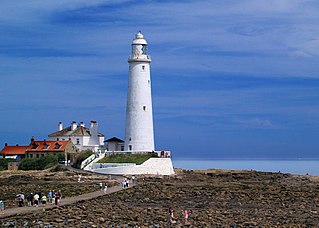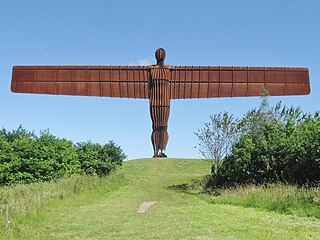
Metropolitan counties are a subdivision of England which were originally used for local government. There are six metropolitan counties: Greater Manchester, Merseyside, South Yorkshire, Tyne and Wear, West Midlands and West Yorkshire.

Tyne and Wear is a ceremonial county in North East England. It borders Northumberland to the north and County Durham to the south, and the largest settlement is the city of Newcastle upon Tyne.

North Tyneside is a metropolitan borough in the metropolitan county of Tyne and Wear, England. It forms part of the greater Tyneside conurbation. North Tyneside Council is headquartered at Cobalt Park, Wallsend.

The Metropolitan Borough of Gateshead is a metropolitan borough in the metropolitan county of Tyne and Wear, England. It includes Gateshead, Rowlands Gill, Whickham, Blaydon, Ryton, Felling, Birtley, Pelaw, Dunston and Low Fell. The borough forms part of the Tyneside conurbation, centred on Newcastle upon Tyne. At the 2021 census, the borough had a population of 196,154.

Newcastle City Council is the local authority for Newcastle upon Tyne, a metropolitan borough with city status in the ceremonial county of Tyne and Wear in North East England. The council consists of 78 councillors, three for each of the 26 wards in the city. It has been under Labour majority control since 2011. The council is a member of the North of Tyne Combined Authority.
Castle Morpeth Borough Council elections were generally held every four years between the council's creation in 1974 and its abolition in 2009. Castle Morpeth was a non-metropolitan district in Northumberland, England. The council was abolished and its functions transferred to Northumberland County Council with effect from 1 April 2009.
Chestler-le-Street District Council elections were generally held every four years between the council's creation in 1974 and its abolition in 2009. Chester-le-Street was a non-metropolitan district in County Durham, England. On 1 April 2009 the council's functions passed to Durham County Council, which became a unitary authority.
Durham City Council elections were generally held every four years between the reforms of 1974 and the council's abolition in 2009. Durham was a non-metropolitan district in County Durham, England. On 1 April 2009 the council's functions passed to Durham County Council, which became a unitary authority.
Easington District Council elections were generally held every four years between the council's creation in 1974 and its abolition in 2009. Easington was a non-metropolitan district in County Durham, England. On 1 April 2009 the council's functions passed to Durham County Council, which became a unitary authority.

West Yorkshire County Council (WYCC) – also known as West Yorkshire Metropolitan County Council (WYMCC) – was the top-tier local government administrative body for West Yorkshire from 1974 to 1986. A strategic authority, with responsibilities for roads, public transport, planning, emergency services and waste disposal, it was composed of 88 directly elected members drawn from the five metropolitan boroughs of West Yorkshire. West Yorkshire County Council shared power with five lower-tier district councils, each of which directed local matters.

Cleveland County Council was the county council of the non-metropolitan county of Cleveland in north east England. It came into its powers on 1 April 1974 and was abolished on 31 March 1996.

North Tyneside Council is the local authority for the metropolitan borough of North Tyneside in Tyne and Wear, England. It is one of five such councils in Tyne and Wear, and one of 36 in England. It provides the majority of local government services in North Tyneside.

The North East Combined Authority (NECA), officially the Durham, Gateshead, South Tyneside and Sunderland Combined Authority, is one of three combined authorities in North East England. It was created in 2014, and currently consists of the City of Sunderland; Metropolitan Borough of Gateshead, South Tyneside; and Durham County local authorities.

South Tyneside Council is the local authority of for the metropolitan borough of South Tyneside in the ceremonial county of Tyne and Wear in North East England. It is one of five metropolitan boroughs in Tyne and Wear and one of 36 in England. It provides the majority of local government services in South Tyneside. The council has been under Labour majority control since 1979. It is based at South Shields Town Hall.

The North of Tyne Combined Authority was a mayoral combined authority which consists the local authorities of Newcastle upon Tyne, North Tyneside, and Northumberland, all in North East England. The authority came into being on 2 November 2018 under the statutory name Newcastle upon Tyne, North Tyneside and Northumberland Combined Authority. The three local authorities previously formed part of the North East Combined Authority, which still exists in a smaller form. The two combined authorities cooperate on the North East Joint Transport Committee.

The 1973 Tyne and Wear County Council election was held on 12 April 1973 as part of the first elections to the new local authorities established by the Local Government Act 1972 in England and Wales. 104 councillors were elected from 95 electoral divisions across the region's five boroughs. Each division returned either one or two county councillors each by First-past-the-post voting for a four-year term of office. The election took place ahead of the elections to the area's metropolitan borough councils, which followed on 10 May 1973.

The 2022 Newcastle City Council election took place on 5 May 2022. One third of councillors — 26 out of 78 — on Newcastle City Council were elected. The election took place alongside other local elections across the United Kingdom.

The 2022 North Tyneside Metropolitan Borough Council election took place on 5 May 2022. One third of councillors—20 out of 60—on North Tyneside Metropolitan Borough Council were elected. The election took place alongside other local elections across the United Kingdom.

The North East Mayoral Combined Authority (NEMCA) is a combined authority in North East England. NEMCA has a directly-elected Mayor and seven member councils; two county unitary authorities and five metropolitan boroughs.

The 2023 North Tyneside Metropolitan Borough Council elections were held on 4 May 2023 alongside other local elections in the United Kingdom. One third of the seats on the council were contested at this election. Labour retained its majority on the council.

















